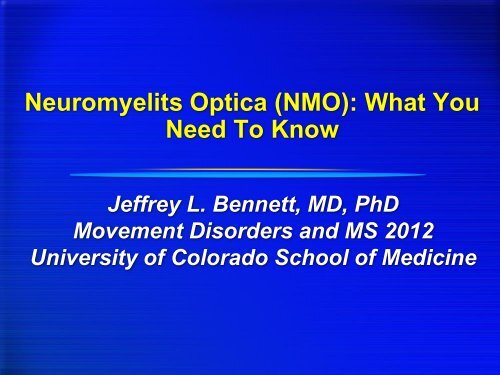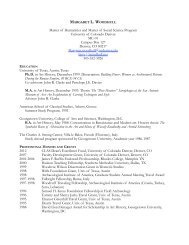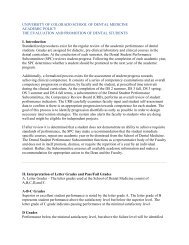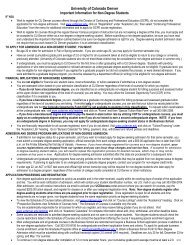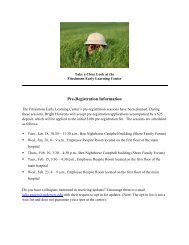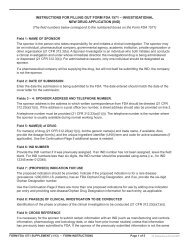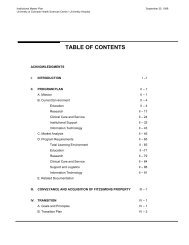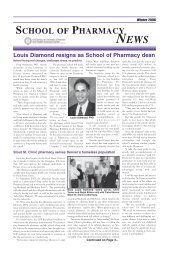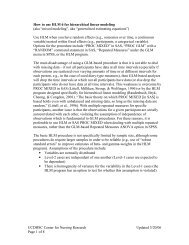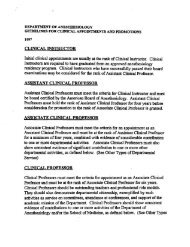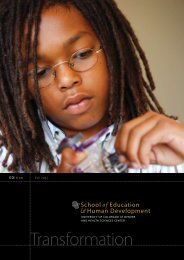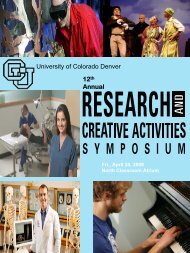Jeffrey L. Bennett, MD, PhD - University of Colorado Denver
Jeffrey L. Bennett, MD, PhD - University of Colorado Denver
Jeffrey L. Bennett, MD, PhD - University of Colorado Denver
Create successful ePaper yourself
Turn your PDF publications into a flip-book with our unique Google optimized e-Paper software.
Neuromyelits Optica (NMO): What You<br />
Need To Know<br />
<strong>Jeffrey</strong> L. <strong>Bennett</strong>, <strong>MD</strong>, <strong>PhD</strong><br />
Movement Disorders and MS 2012<br />
<strong>University</strong> <strong>of</strong> <strong>Colorado</strong> School <strong>of</strong> Medicine
Disclosures<br />
Consultant: Teva Neuroscience, E<strong>MD</strong> Serono,<br />
Accorda Therapeutics, Novartis, Biogen-Idec,<br />
Questcor<br />
Intellectual property: Aquaporumab<br />
No FDA approved treatments for NMO
Learning Objectives<br />
Enumerate the diagnostic criteria for NMO.<br />
Summarize cardinal features <strong>of</strong> the<br />
pathophysiology <strong>of</strong> NMO.<br />
Differentiate signs and symptoms <strong>of</strong> neuromyelitis<br />
optica and multiple sclerosis.<br />
Organize a diagnostic plan for the evaluation <strong>of</strong> a<br />
patient with possible NMO.<br />
Implement acute and chronic therapies for NMO<br />
patients.
Neuromyelitis Optica<br />
History<br />
Clinical Clues<br />
Imaging Clues<br />
Laboratory Clues<br />
Treatment<br />
Future Therapies
History<br />
Albutt (1870) “On the ophthalmoscopic signs<br />
<strong>of</strong> spinal disease” Lancet 1:76.<br />
Devic (1894) “Myélite subaiguë compliqué de<br />
névrite optique” Bull méd 8: 1033.<br />
Balser (1936) “Neuromyelitis Optica” Brain<br />
59: 353<br />
• Nosology: NMO vs MS, diffuse myelitis, & ADEM<br />
• Clinical & Pathological Criteria<br />
–Bilateral optic neuritis and myelitis<br />
–Infiltrating demyelination<br />
•Diffuse > Disseminated
Are MS and NMO Distinct or Related?<br />
MS<br />
NMO<br />
MS NMO<br />
OR MS OR<br />
NMO<br />
MS NMO
Clinical Criteria (Modern Era)<br />
Absolute Criteria*<br />
1. Optic Neuritis<br />
2. Transverse Myelitis<br />
3. No evidence <strong>of</strong> brainstem or cerebral<br />
disease<br />
* Strict – coincidental<br />
Not strict – 2 nd event within 2 years<br />
Wingerchuk et al. (1999). The clinical course <strong>of</strong> neuromyelitis<br />
optica (Devic's syndrome). Neurology, 53(5), 1107–1114.
NMO: Index Symptoms & Recovery<br />
Feature Monophasic NMO Recurrent NMO<br />
Sex (F:M) 11:12 40:8<br />
Median Age 29 (1-54) 39 (6-72)<br />
Index Event (%)<br />
Optic Neuritis (ON)<br />
Myelitis<br />
Bilateral ON<br />
Myelitis + ON<br />
Bilateral ON + myelitis<br />
Index Event at<br />
Recovery<br />
Optic Neuritis<br />
Myelitis<br />
6 (26%)<br />
5 (22)<br />
4 (17)<br />
1 (4)<br />
7 (31)<br />
Better than 20/30<br />
MRC 3-4<br />
23 (48%)<br />
20 (42)<br />
4 (8)<br />
1 (2)<br />
0<br />
Better than 20/30<br />
MRC 5- to 4+<br />
Wingerchuk et al. (1999) Neurology 53:1107.
1999 NMO Imaging<br />
Negative brain MRI (90%)<br />
Non-specific lesions (43%)<br />
Spinal MRI with lesion over<br />
3 vertebral segments (91%)
Cerebrospinal Fluid in NMO<br />
Parameter NMO MS<br />
Pleocytosis (> 5 cells) 29.3% - 82% 24.6%<br />
Differential Granulocytic Lymphocytic<br />
Total Protein (mean) 75 mg/dl 38 mg/dl<br />
OCB 23-35% 97%<br />
McAlpine (1968); Wingerchuk (1999); Ghezzi (2004); Bergamashi (2004)
NMO-IgG<br />
NMO Antibody<br />
• IgG antibody<br />
• Pial and microvessel<br />
staining<br />
• Target: Aquaporin-4 Water<br />
Channel (AQP4)<br />
• 73% Sensitive<br />
• 91% Specific<br />
High Risk Syndromes<br />
Recurrent ON: 25% Sensitive<br />
LETM: 50% Sensitive<br />
Lennon et al. (2004) Lancet 364: 2106.<br />
Lennon et al. (2005). JEM, 202:473.
EAE<br />
AQP4 Antibodies Are Pathogenic<br />
Anti-AQP4 rAb<br />
Serum NMO-IgG<br />
NMO<br />
Kinoshita et al., Biochem Biophys<br />
Res Comm, 2009<br />
<strong>Bennett</strong> et al., Annal Neurol, 2009<br />
Bradl et al., Annal Neurol, 2009<br />
Complement +<br />
Serum NMO-IgG<br />
NMO<br />
Saadoun et al., Brain, 2010<br />
Ex Vivo Spinal Cord Explants<br />
Zhang et al., Annal Neurol, 2011
NMO-IgG: A Specific Marker <strong>of</strong> NMO<br />
Waters, P. J. et al. (2012). Neurology, 78(9): 665<br />
Is seronegative NMO the same disease?<br />
Takahashi et al. (2007) Brain 130:1235<br />
Jarius et al. (2007) Neurology 68:1076<br />
Waters et al. (2008), Arch Neurol 65:913<br />
Kalluri et al. (2010), Arch Neurol, in press
Neuromyelitis Optica (NMO)<br />
Revised Diagnostic Criteria<br />
Major criteria:<br />
1. Optic Neuritis<br />
2. Acute Myelitis<br />
2 <strong>of</strong> 3 minor criteria:<br />
1. Contiguous spinal cord lesion<br />
(≥ 3 segments)<br />
2. Brain MRI not consistent with<br />
MS<br />
3. AQP4-IgG<br />
*Wingerchuk et al. (2006) Neurology 55:1485<br />
NMO IgG<br />
• IgG antibody<br />
against AQP4
NMO: Clinical Syndromes<br />
Recurrent Optic Neuritis<br />
Longitudinally-extensive Transverse Myelitis<br />
NMO Spectrum Disease (+ AQP4-IgG)<br />
Intractable hiccups<br />
Intractable nausea-vomiting<br />
Encephalopathy<br />
Brainstem/Cerebellar symptoms<br />
McKeon (2008). Neurology, 71(2), 93.<br />
Pirko (2004). Arch Neurol, 61(9), 1401.<br />
Popescu (2011). Neurology, 76(14), 1229.<br />
Takahashi (2008). JNNP, 79(9), 1075.
Recurrent Optic Neuritis: NMO Risk?<br />
5-year conversion rate:<br />
• 12.5% NMO<br />
• 14.4% MS<br />
≥ 2 MRI lesions: increased risk <strong>of</strong> MS<br />
No MRI lesions: NMO risk not increased<br />
20-27% AQP4-IgG Seropositivity<br />
Pirko et al. (2004) Arch Neurol 61:1401.<br />
Matsushita et al. (2009) Multiple sclerosis 15:834.
Optic Neuritis and NMO: Clinical Pearls<br />
Increased Suspicion<br />
Severe vision loss (< 20/200)<br />
Severe visual field loss (<strong>MD</strong> < -11 dB)<br />
Poor visual recovery (< 20/60)<br />
Posterior optic nerve involvement (MRI)<br />
Optic chiasm involvement<br />
Fernandes et al. (2012). J Neuro-Ophthalmol, 32:102.
MS and NMO: Ocular Coherence Tomography<br />
15 mM RNFL loss with poor<br />
visual recovery and atypical MRI<br />
Ratchford et al. Neurology (2009) vol. 73: 302-8 Naismith et al. Neurology (2009) vol. 72: 1077-82
Imaging in NMO Patients<br />
60% <strong>of</strong> NMO patients<br />
10% with MS pattern lesions<br />
•83% were NMO-IgG positive<br />
•66% fulfilled Barkh<strong>of</strong> criteria<br />
Pittock, S. J. et al. Arch Neurol 2006;63:390.
Unusual Brain MRI Lesions in NMO Patients<br />
Pittock, S. J. et al. Arch Neurol 2006;63:964-968.
NMO: Laboratory Clues - Serum<br />
Autoimmune Serology<br />
ANA – 44%<br />
SSA – 15.7%<br />
Thyroid Abs – 16.7%<br />
Acetylcholine Receptor Abs – 11%<br />
Anti-Glutamic acid decarboxylase Abs – 15%<br />
Pittock et al. (2008). Arch Neurol 65:78.<br />
McKeon (2009). Muscle & nerve, 39:87–90.
NMO: Laboratory Clues - CSF<br />
Pleocytosis > 50 cells/microliter<br />
Elevated polymorphonuclear cells<br />
Eosinophils<br />
AQP4-IgG<br />
Negative oligoclonal bands<br />
Jarius et al. (2011) J Neurol Sci, 306:82.<br />
Klawiter et al. (2009). Neurology, 72:1101.
NMO: To Treat or Not To Treat<br />
AQP4-IgG Seropositivity<br />
50% chance <strong>of</strong> relapse in 1 year<br />
Visual Prognosis<br />
•70% severe vision loss in one eye (8 yrs)<br />
–MS Cohort: 8.5%<br />
•Average time to severe vision loss<br />
–Monocular: 2 ± 0.8 years<br />
–Binocular: 13 ± 3 years<br />
Ambulatory Prognosis<br />
• Median time to EDSS 4: 7 years<br />
• Median time to EDSS 6: 10 years Collongues, et al. (2010).<br />
Neurology, 74:736.
NMO Therapy<br />
Acute Exacerbations<br />
Corticosteroids<br />
Plasma exchange<br />
Preventative Treatment<br />
Azathioprine<br />
Mycophenolate m<strong>of</strong>etil<br />
Methotrexate<br />
Rituximab<br />
Corticosteroids<br />
Mitoxantrone
NMO Treatment: Corticosteroids<br />
Increased rate <strong>of</strong> recovery<br />
Intravenous Methylprednisolone<br />
1000 mg dosage<br />
3-5 days<br />
Role <strong>of</strong> steroid taper unknown<br />
Incomplete recovery<br />
Bridging therapy
NMO Treatment: Plasma Exchange<br />
Administration<br />
Concurrent or following IVMP<br />
5 cycles: Daily or every other day<br />
Improved Outcomes<br />
Optic Neuritis<br />
Visual acuity, visual fields, RNFL thickness<br />
Transverse Myelitis<br />
Faster improvement, improved EDSS<br />
Bonnan et al. (2009). Multiple sclerosis 15(4):487.<br />
Merle et al. (2012) Arch Ophthalmol 130:858.
NMO Treatment: Azathioprine<br />
inhibits de novo purine synthesis; limits B and T cell<br />
proliferation<br />
Dosage: ≥ 2mg/kg daily<br />
MCV increase <strong>of</strong> ≥ 5 points<br />
Benefits: ARR reduced to 0.4-0.52; EDSS reduction<br />
Adverse events: nausea, hepatotoxicity, leukopenia,<br />
diarrhea, hair loss, bone marrow suppression, fatigue;<br />
check thiopurine methyltransferase activity to avoid<br />
drug toxicity<br />
Costanzi et al. (2011). Neurology, 77:659.<br />
Mandler et al. (1998). Neurology, 51:1219.<br />
McKeon et al. (2008). Neurology, 71:93.
NMO Treatment: Mycophenolate M<strong>of</strong>etil<br />
hinders de novo synthesis <strong>of</strong> guanosine<br />
nucleotides; limits B and T cell proliferation<br />
Dosage: 1 gram twice daily<br />
Benefits: ARR reduced to 0.2; EDSS<br />
reduction<br />
Adverse events: leukopenia, headache, hair<br />
loss, diarrhea, skin malignancy, lymphoma,<br />
PML<br />
Jacob et al. (2009). Arch Neurol 66:1128.
NMO Treatment: Methotrexate<br />
inhibitor <strong>of</strong> dihydr<strong>of</strong>olate reductase and<br />
purine and thymidine synthesis<br />
Dosage: 7.5 – 15 mg weekly<br />
Benefits: Reduction or stabilization <strong>of</strong> ARR<br />
and EDSS<br />
Adverse events: leukopenia, stomatitis,<br />
nausea, infection<br />
Minagar A. Int J MS Care 2000;2:39.
NMO Treatment: Rituximab<br />
anti-CD20 mAb that depletes B cells from pre-B<br />
through memory lineages<br />
Dosage: 1000 mg IV on days 0 and 15<br />
Repeat every 6 months or if B cells > 5%<br />
Benefits: ARR reduced to 0.0-0.3; EDSS<br />
reduction<br />
Adverse events: infusion reactions, infections,<br />
PML.<br />
McKeon et al. (2008). Neurology, 71:93.<br />
Cree et al. (2005). Neurology, 64:1270.<br />
Jacob et al. (2008). Arch Neurol 65:1443.<br />
Kim et al. (2011). Arch Neurol 68:1412.
NMO Prevention: Methylprednisolone<br />
binds to glucocorticoid receptor, induce gene<br />
expression, and modulate immune function<br />
Dosage: 2.5 mg/d to 25 mg/d<br />
Benefits: ARR reduced to 0.49<br />
Adverse events: insomnia, mood changes,<br />
weight gain, glaucoma, osteoporosis,<br />
diabetes, hypertension, and growth<br />
impairment in children<br />
Watanabe et al. (2007) Multiple sclerosis 13:968.
NMO Prevention: Mitoxantrone<br />
intercalates DNA and inhibits topoisomerase<br />
II, limits B and T cell proliferation<br />
Dosage: 3 monthly cycles: 12 mg/m 2 ;<br />
maintenance <strong>of</strong> 6-12 mg/m 2 every 3 months<br />
Benefits: ARR reduced to 0.7; reduced EDSS<br />
Adverse events: cardiotoxicity, leukemia,<br />
hepatotoxicity, leukopenia<br />
Weinstock-Guttman et al. (2006). Arch Neurol 63:957.<br />
Kim et al. (2010). Arch Neurol 68:473.
NMO: Immunopathology<br />
NMO-IgG<br />
Anti-AQP4<br />
Memory B Cells<br />
Plasma Blasts
NMO: Etiology<br />
Molecular Mimicry<br />
Infection<br />
Bystander Activation<br />
NMO: HLA DRB1*03 (DR3) 1<br />
OSMS: HLA DPB1*0501<br />
(AQP4+) 2<br />
Aquaporin-4<br />
? Others<br />
• MYCOBACTERIUM<br />
• VARICELLA<br />
ZOSTER<br />
• MYCOPLASMA 3
TARGETS FOR NMO THERAPY<br />
complement<br />
astrocyte<br />
Myelinolysis<br />
Axonal transection<br />
AQP4-IgG<br />
cytokines<br />
lymphocytes<br />
eosinphils<br />
ADCC, phagocytosis<br />
neutrophils<br />
macrophages<br />
Inflammatory response
NMO: Th17 Immunopathology<br />
Clinical Science (2012) 122, 487-511 - Shu<br />
Zhu and Youcun Qian<br />
*<br />
Anti-AQP4<br />
Wang, H. H. et al. (2011). J Clin<br />
Neurosci 18(10), 1313–1317
NMO Pathogenesis: IL-6 and Interferon<br />
Elevated IL-6 in NMO CSF 4<br />
• Correlation with CSF Anti-AQP4 IgG Titer<br />
Elevated peripheral blood plasma blasts 5<br />
• IL-6 Anti-AQP4 IgG-expressing Cells<br />
Elevated Type 1 interferon Signature 6<br />
• IFN-b Exacerbates Disease Activity 7<br />
Icoz et al., Int J Neurosci, 2010<br />
Control<br />
AQP4<br />
Chihara et al., PNAS, 2011
Neutrophils Enhance NMO-IgG Mediated Pathology<br />
Neutrophilia<br />
Neutropenia<br />
Neutrophil<br />
Elastase<br />
Inhibitor<br />
Saadoun et al., Ann Neurol, 2012
ANTIGEN SPECIFIC NMO THERAPY<br />
SMALL MOLECULE BLOCKERS<br />
• Arbidol<br />
• Berbamine<br />
• Tamarixetin<br />
Tradtrantip et al.,<br />
FASEB J, 2012<br />
NON-PATHOGENIC AQP4<br />
BLOCKING ANTIBODIES<br />
Tradtrantip et al..<br />
Ann. Neurol., 2012


